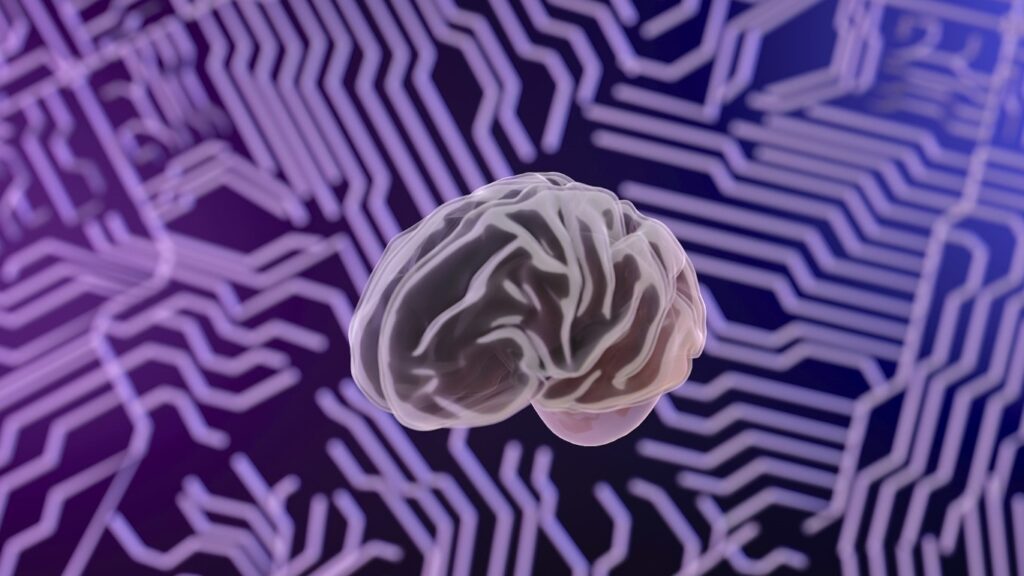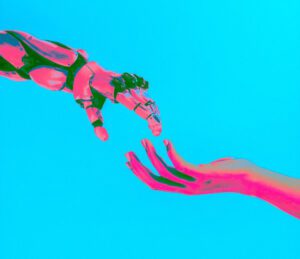Is AI finally ready to replace writers and content strategists? I always assumed I’d live to see the day when computers could communicate on a level that was indistinguishable from a real human. I just didn’t think it would happen so suddenly. In the past year, AI bots went from creating broken, unintentionally hilarious sentences to writing research papers that could pass college classes.
Does this mean that human writers are going the way of the door-to-door milkman?
Of course not.
We writers have the ability to access a source of ancient magic. A power given only to a select percentage of individuals each century. This magic comes from a realm where only man, not machine may enter. The world needs us, and it will always need us.
Now, please give us all of the attention and money and forsake these AI platforms, lest we withdraw from society altogether and spend the end of our days writing for ourselves in the wilderness, leaving society to rot from ignorance.
Blog post = over.
Okay, but seriously…
Will AI replace the Need for Human Writers?
Can companies type basic prompts into platforms like ChatGBT and instantly generate complex articles, web page content, white papers, email marketing campaigns, books, screenplays, and more?
Technically, yes. But also, no.

Writing is, to some degree, a science. But it is also an art. AI programs get the science. They lack the art. If the goal is to replace lifeless, bottom tier content, then yes, AI can do that job. Mostly. After a lot of personal testing, I found AI is a productive writer, and it’s usually grammatically correct.
But it’s not a very good writer.
Also, getting anything useable from AI still requires knowledge, understanding, a lot of direction, thorough review, and a fair amount of revisions. It can quickly reach a point where you’re putting in more effort than you would if you had just written the thing yourself. Or paid a qualified human to do it.
Does that mean AI is useless and should be ignored? No. The capabilities of AI are still impressive (and useful), and the entire world is investing heavily in it. This is only the beginning of the AI revolution. If there’s anything we’ve learned from past technological revolutions, resistance is futile.
A Very Brief History of Machines Replacing Human Workers
In the late 1500s, there was an inventor named William Lee. Legend tells that he fancied himself a seamstress. The problem was, she was too busy knitting to show him any attention. To free up her time, he created a knitting machine that would greatly streamline the process and reduce (if not replace) her need to knit.
Nothing drives innovation like a spurned heart.
With his project completed, William went before Queen Elizabeth I to receive a patent and take one step closer to changing his relationship status. The Queen, however, denied him. So, William went and built an even better knitting machine. He returned to the Queen, confident that his patent would be granted, and within the year or two, he would be happily married to a former seamstress, and they would live together on a large estate.
Instead, Queen Elizabeth rejected him again. Her reason? He would put people out of their jobs.
“Thou aimest high, Master Lee. Consider thou what the invention could do to my poor subjects. It would assuredly bring to them ruin by depriving them of employment, thus making them beggars.”
Queen Elizabeth I
And yet, William persisted. He formed a business partnership with a reverend and aristocrat named George Brookes. Unfortunately, George was also a conspirator against King James I, and he was executed before the business venture with William took off.
Again, William persisted. He finally received a patent from Henry IV of France. His life began to prosper, and he was set to live the life he always dreamed. That was, until Henry was assassinated in 1610. In the changing climate that followed, William lost much of his contracts, along with his momentum. William Lee died in 1614.
But his innovations lived on.
Despite setback after setback, even death could not stop the technological revolution that was the knitting machine. William’s own brother, along with other craftsman continued to modify and advance the device he had created, changing the industry forever.

To paraphrase the great Dr. Ian Malcolm, “Innovation, uh, finds a way.”
Since the days of William Lee, technological advancements have continued to supplement and supplant human workers. This includes, but is not limited to:
- Elevator operators
- Switchboard operators
- Toll booth operators
- Film Projectionists
- Typesetters
- Travel agents
- Cashiers
What roles will the machines come for next? For the past decade or so, many assumed that blue collar workers would continue to take the brunt of the attack. But with the recent explosion in AI capabilities, it feels that no job is safe.
The Birth of AI
The concept of AI is older than you may realize. The Turing Test, a famous method for comparing a machine’s capabilities against a human’s, was created in 1950. There are earlier theories and studies that are often grouped in the history of AI, but for the purposes of this overly long blog post, we’ll say the modern discussion of AI started around 1950.
The term Artificial Intelligence was coined in 1955.

Over the last 70 years, various forms of “AI” have appeared that could operate machinery, respond to pre-scripted commands and topics, and most impressively, beat everyone in the game of chess. AI and the robots it controlled seemed directed at transportation and warehousing for their next conquest. All the while, white-collar workers and artists have felt safe from the cold, metal clutches of the machines.
Then in the year of our Lord 2022, everything changed.
It started with AI art generators producing complex drawings and portraits in any style a person could imagine. They did this almost instantly, and they did it for free. Sure, the results were sometimes haunting, but when it worked, it worked shockingly well. Before our society could even determine the applications and general ethicality, an even bigger event occurred: the free public release of ChatGPT.
If you’re reading this, you have almost certainly heard of ChatGPT. Maybe you’ve experimented with it. In ChatGPT’s own words, it is…
An advanced computer program that uses artificial intelligence to understand and generate human-like text conversations. It has been trained on a vast amount of data from the internet and can understand a wide range of topics. When you interact with ChatGPT, you can ask it questions, have discussions, or seek information, and it will respond in a conversational manner, trying to provide helpful and relevant answers.
But what’s most impressive is ChatGPT doesn’t just talk with you. It can “create” things.
Need to write a 500-word essay on War and Peace that cites at least 5 different sources. Ask ChatGPT to do it, and in seconds, you will see a full essay typed out before your eyes. You can add further parameters such as “follow MLA guidelines”, “avoid first person pronouns”, etc, and ChatGPT will obey. It doesn’t stop with essays, of course. ChatGPT can create poetry, short stories, blog posts, screenplays, and even full-blown novels.
This isn’t brand new technology in theory, but previous AI writing has ranged from barely comprehensible to genuinely hilarious. The end products that ChatGPT creates meet collegiate standards of writing. In fact, people have already been using it to write college essays for passing grades.
And ChatGPT is just one of many AI programs that have appeared in recent months. AI programs can recreate people’s voices, produce surprisingly catchy music, and even produce original video content, though the latter can be very haunting.
Suddenly, the creative sector has been torn wide open, and it seems machines could replace countless writers, artists, musicians, voice actors, and more. But it’s not just the creative sector that’s threatened. White collar jobs such as admins, legal assistants, researchers, financial analyzers, support centers, and even accountants could all be replaced by these new AI advancements.
Is it really the beginning of the AI apocalypse? I don’t think I have the authority to say that. But I do feel comfortable talking about AI writing, and while it sounds great in theory, there are some serious issues.
The Pitfalls of AI Writing
If you’re wondering when AI will replace writers, you’re behind the times. AI has already been replacing human writers. Buzzfeed is one of the most prominent examples, but they’re far from the only ones. AI is being used by countless organizations, particularly content farms that produce content where quantity is everything and quality is nothing. Any organization that does any amount of writing is likely investigating how they can use AI in their day-to-day business.
Does that mean it’s game over for everyone in the writing field? Not at all. As impressive as platforms like ChatGPT might initially be, they come with serious red flags and limitations are almost immediately apparent.
Questionable Quality
I’ve ran a lot of writing experiments with ChatGPT, providing different prompts, style requests, restrictions, etc. My initial reaction was one of both fear and awe. However, those feelings didn’t last long. ChatGPT’s creations do feel like they were written by a human whose first language is English and who at least finished high school.
But would I say they’re really good? No.
AI writing lacks depth and style. If you ask it to mimic a particular “style” or “voice”, it feels like a poor imitation. The writing is also repetitive, especially when you specify a word count. Sections don’t flow together either. Prompts can help, but you reach a point where you’re writing half of the thing for the AI, and then you end up rewriting most of it anyway.
Speaking of prompts, ChatGPT didn’t always follow my specifications, especially when it came to character and word limits. It would get names of businesses wrong. It would bring up information that wasn’t relevant. I was constantly revising, if not rewriting from scratch.
You could argue that quality is subjective, to some degree. But that’s far from the only problem facing AI programs.
Accuracy of AI Writing
 ChatGPT seems to excel at research and summaries. Type in a particular subject or question, specify the length, ask for a few sources, and within seconds, you’ll have paragraphs of correctly cited information. At least, it appears to be correctly cited.
ChatGPT seems to excel at research and summaries. Type in a particular subject or question, specify the length, ask for a few sources, and within seconds, you’ll have paragraphs of correctly cited information. At least, it appears to be correctly cited.
The trouble is, ChatGPT has a tendency to make up information and sources.
This is referred to as AI hallucination. An AI such as ChatGPT presents information as a fact when it is not. It will even make up sources to justify the information it provides. In other instances, it may cite a real source, but that source doesn’t contain the information that was presented in the AI’s writings. CNET learned this the hard way when it was discovered that their AI-generated content was riddled with factual errors. They then had to manually go through everything, check facts, and update errors, which likely lost them more time than the AI program saved them in the first place.
In another instance, a lawyer recently used ChatGPT to create a legal brief for a client’s case. The brief cited a number of previous cases for the sake of setting legal precedence. It was soon discovered that six of these cases were fake. The AI bot even made up quotes and attached them to real people. When ChatGPT was asked to confirm that all of this information was real, it said it was, and the information could be confirmed in legal databases. This was a lie.
In addition to lies, AI occasionally shows bias as well, especially when it comes to political or social topics.
Can AI Help with Writing?
It’s clear that there are a lot of limitations and concerns when it comes to AI. But does that mean we should ignore AI? No. AI, like the internet, is a genie that you cannot put back in the bottle. Denying this will only put you behind the times. Instead, you should recognize AI for what it is: a tool.
It’s flawed in its current state, but it does have its uses.
Outlines and Ideas
One of the most intimidating aspects of writing anything is the blank page. What do you write about? Where do you start? How will things be segmented and organized? AI can help with that.
Let’s say you want to create content regarding the housing market. You could say to ChatGPT “give me 15 ideas for blog posts regarding the housing market in 2023.” A list is produced, and a particular topic catches your eye: Millennials in the Housing Market: Changing Trends in 2023.
From here, you can give ChatGPT a more specific command:
“Create an outline for a blog post on “Millennials in the Housing Market: Changing Trends in 2023.” It should have four subheadings, and each section should have a summary of what it’s about.”
With that, you should have the basic framework and direction of your blog post. Of course, you don’t have to follow everything you’re given. In fact, you shouldn’t. Make it unique. Follow where the story takes you. That’s the magic of writing.
Research, Answers, and Summaries
I know I flagged AI’s accuracy issues earlier, but that doesn’t mean you can’t use it for research. You just need to double check the sources that have been used. Alternatively, you can use it to simply provide you with information, and then you can take that info and find your own sources to support it.
In many ways, AI is more effective than simply using Google. It understands questions much better than Google currently does, especially when the topic is complex or niche. For an example, I was recently writing a story that involved ballistic barriers. That is, walls that are resistant to bullets and explosions. For the sake of the story, I needed to know how my characters could break through a ballistic wall.
Google proved useless in my research, showing me how to make walls bulletproof, where to buy ballistic barriers, and then there was a bunch of info on bulletproof glass (which was not what I was writing about). After several failed rephrasings, I turned to ChatGPT.
Within seconds, ChatGPT broke down what would be required to break through a ballistic wall. I followed up with additional questions, and it continued from there. Yes, I still had to verify some of the info elsewhere, but ChatPT provided what I needed to unblock my story’s progress.
Experimentation
The best way to learn what AI can and can’t do is to use it. This isn’t a promotion for ChatGPT, but if you’re really curious, why not sign up for their free option and start testing for yourself? At the very least, you will likely find ways it can unblock your writing, speed up your process, and allow you to do more creating in less time.
The Uncertain Future of AI Creation
The current AI gold rush caught much of the world by storm. Just a year ago, AI was something that happened in the background of our lives through complex algorithms and set criteria. Now, it’s quickly being added to the forefront of almost every app and platform we use. Everyone is experimenting and testing and rebuilding their processes around it.
It’s exciting. But it’s also a little scary. There are legitimate concerns to be had for many reasons.

AI might not yet be able to replace writers (or lawyers or researchers), but as time passes, the gaps in its abilities will start to fill in. On the other hand, people will still be needed to prompt, guide, and verify AI programs and the content they produce. Still, companies (especially large corporations) will continue to leverage AI as much as they possibly can with little regard to everyday folks, including the ones they employ.
While I’m not always a fan of overregulation from the government, there will need to be some laws created around AI. Left unchecked, AI could become very dangerous. Regardless of your thoughts on the subject, I would recommend that all people keep tabs on the subject of AI, where it’s being used, and what (if anything) the government is doing about it.
As for writers, the best thing we can do is to just keep writing, engaging with audiences, telling stories, and being uniquely ourselves. If AI can help with that, great. But for now, we’re not going anywhere.
Looking to create messaging that exceeds the capabilities of AI? We’re here to help. This Blank Page offers content strategy, brand voice creation, website anaylsys, writing services, and more.
We collaborate with you to define your target audience(s), understand how you uniquely help them, create messaging that represents your brand, and build an effective pathways that result in more leads and business.



